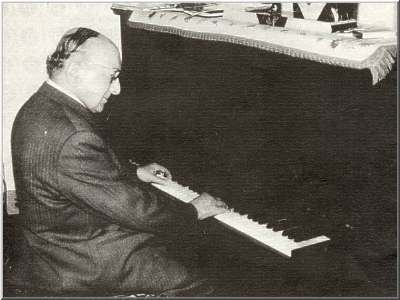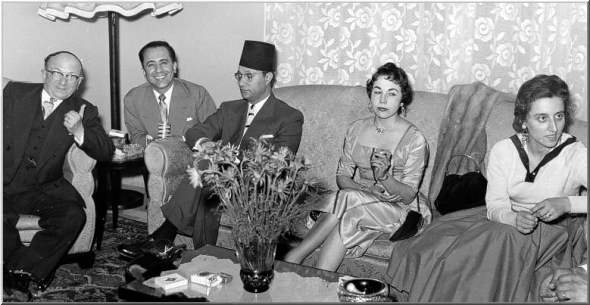ABDALLAH CHAHINE
when the Orient meets the Occident again
Translation : Celia Eid
 |
| Abdallah Chahine at his piano ( the Chahine family's collection ) |
Translation : Celia Eid
 |
| Abdallah Chahine at his piano ( the Chahine family's collection ) |
Version française
Abdallah Chahine was born in 1894 and he was still a teenager when he discovered his passion for oriental music. His father, who did not want him to become a "troubadour", accepted to offer him a little harmonium. Thus, he could develop his imagination and, very quickly, his improvisations revealed an exceptional feeling for music and a refined taste for oriental music. He was only fourteen years old at the time.
For many years, he played harmonium for all the services at St Joseph’s Church in Beyrouth. Priest Colingite, amazed by the gifts of this young man, urged his parents to send him study to Vienna’s Musical School but they refused. It did not prevent him from taking up a career linked to music; that is mending and tuning pianos, which he actually did with great dexterity. He was even among the first ones to import Occidental musical instruments to Lebanon.
His passion for tuning pianos never left him even when he was very old. His niece, Dany, even says that even when he was old, with no longer the strength to screw the cords, he had to resign himself to trust it to one of his pupils Assad Hanna. Nevertheless, he always insisted to assist to the manipulation!
Abdallah Chahine with his the frame of a piano.
( the Chahine family's collection )Chahine’s daughter, Amira, and his sons Joseph, Richard, Mozart, Bertrand, Antoine and René have been managing his house of Commerce (founded in 1952) since he died on 9th January 1975. Fortunately, they have succeeded in applying a dynamic commercial policy. Nowadays, the A. Chahine & Fils’s House is one of the most important companies specialized in selling instruments and producing "Voix de l’Orient" records. He is famous all over the world, in particular thanks to the Oriental piano with ¼ tone which he made with the help of the Austrian manufacturer Hoffman.
Chahine’s piano is an authentic oriental-occidental straight piano. Since 1954, it has been made in Vienna by Hoffman’s factories with the help of Renner’s factories, in Stuttgart, for reflection and tests, as early as 1930-1931, he invented the prototype out of an old straight piano which had cords and a keyboard of 6 octaves.
This new piano was first shown in an exhibition in 1954 at the Austrian Pavilion in Damascus. Two years later, while showing the numerous possibilities of his instruments to the members of the UNESCO Congress in Beirut, Chahine declared: "This prototype has been made and transformed by myself, with the rudimentary means that I had at my disposal. What you have here is the result of 40 years of labor. It gives us the basic intervals which enable us to play the main melodies and modulations with their differences, plus the Arabic tones that can be played on the occidental tempered keyboard."
Later on, in 1962, thanks to a prototype, which he had in his flat in Beirut, he recorded a vinyl record with typical oriental music.
In the evening of the 13th March 1974, Abdallah Chahine was awarded knight by the order of the Cedar –he was aged 80 years old. At that time he said: "Even thought I’m old I hope I’ll be able to carry on my activities for a long time. The oriental piano which I’ve invented is left at the disposal of everybody."
The musicologist Jacques Chailley has talked a lot about Chahine’s piano, insisting on "its educational interest in abolishing the barrier between the two oriental and occidental musical civilizations." For Marc-Henry Manguy, " the "Taqsims1"1 improvised and recorded by this inventor and highly qualified player, are still here nowadays to witness the rich inspiration which Arabic music can provide when it is handled and thought of by an artist who manages all types of music". Aloys Haba, a famous Czech composer (1893-1973) has applauded the simplicity and the perfection of this technical achievement. Left it be noticed that Aloys Haba - who is known for his interest in oriental traditional music and his compositions in intervals of tones smaller than half a tone - and the Russian composer Ivan Vychnégradsky (1893-1979) have made a piano with two keyboards; one of them being toned ¼ tone higher than the other.
But how does Chahine’s piano work? What are its characteristics and its particularities?
Its board composed of 7 octaves and a quarter has got 88 keys ranging from A –1 to A 7 as many hammers as keys. There are quadrupled cords for medium and acute stops, which gives them the following composition:
Abdallah Chahine with friends, near a piano frame.
( the Chahine family's collection )- Register "double bass" stops: 12 notes, 12 cords.
- Register "low" stops: 18 notes, 18 double cords.
For each octave, there are 5 notes having a double function (Oriental and Occidental) - each note being connected to the Oriental and also to the Occidental board. The medium and acute register is composed of 58 quadrupled cords (grouped by pairs), that is 232 cords (4 cords per hammer). In that register, there are 58 Occidental notes and 24 extra notes.
To sum up, there are a total number of 31 added oriental notes, and there are 119 notes possible on the board (with 280 cords). Let’s remember that on ordinary occidental piano has only got 224 cords.
Abdallah Chahine has added 5 new intervals to the 12 ½ tones of the tempered scaled with the 5 new tones. B
b, Eb, Ab, Dband F#, thus, enabling us to play the different modes, or Oriental maquams2, like the Bayati, Rast or Saba... The divisions of these Oriental tones are called ¼ and ¾ tones. It was not without any difficulty that Abdallah Chahine has succeeded in solving all these mathematical problems. The mode of the new "Chahine instrument "switches instantly from the Oriental to the Occidental expression thanks to a third medium pedal. When the pedal is lowered, the piano plays the occidental tempered scale. When it is lifted, the piano plays on the Oriental tone.
 |
| Abdallah Chahine (on the left) with the singer Mohamed Abdel Wahab (in the middle) and the singer Feyrouz (on the right). ( the Chahine family's collection ) |
Beirut's seaport
( SOLIDERE photo, Société Libanaise pour le Développement et la Reconstruction du Centre-Ville de Beyrouth )Even if, as far as the melodic expression is concerned, Chahine’s piano could never be comparable with any other mobile instrument (such as the Oriental luth, the violin…), it, nonetheless, enriches the variety of the Oriental orchestra by its purely piano characteristics. For a long time, this instrument has interested singers such as Abdel Wahab (one of the greatest composers of the Arab world in the twentieth century – he gave a new tone to Oriental music) and Feyrouz. – The voice that had an immense success at Baalbeck festivals in 1998. Lebanese musicologists such as Louis Hage, composers such as Father Joseph Khoury (head of the Academy of Music of Beirut), Georges Baz, Boghos Gélalien or Toufic Succar. Its contribution to the improvement of Arabic music is paramount for the future of this music that is beginning to mark its roots in the polyphonic science and the mystery of ¼ a tone harmony. Composer Toufic Succar has realized it and his first tests in that field have been a real success.
Abdallah Chahine - always eager to improve things - did not stop after this invention. He has used it on other instruments, which are the harmonium and the accordion. Instead of the pedal, you merely have to lower the key of a register. Later on, in April 1974, the first oriental-occidental electric organ appeared. The instruments provide an almost unlimited range of possibilities.
Let us finish this study with a few word from Marc-Henry Mainguy: "Now that we have reached point in history when the Mediterranean countries from the East to the West and from the North to the South are meeting again, after 500 years, perhaps it is time to renew the artistic link especially in music- between these cultural theories which are very closed together and, more or less, from the same families through History. Thanks to its singularity, Abdallah Chahine’s piano could help this renewed relationship between the Orient and the Occident."
Rita Eid
____________
Teacher at Beirut Academy of Music1) Taqsims are types of instrumental improvisations, which are not measured. [NDLR] [ Retour ]
2) We know that the notes of a scale can be distanced in different ways, so as to compose different modes. Theorists believe that there are 96 modes or maquams. In Lebanon, we use about twenty of them. [NDLR] [ Retour ]
References :
Newspaper, L'Orient le Jour (1974)
Marc Henri Mainguy, Vie musicale.
Safa, Les reflets de la ville, p.11.
Correspondance of Jacques Chailley
Conference of Abdallah Chahine at the UNESCO Palace in 1956
Louis Hage, Un piano occidental-oriental
Conversation with Abdallah Chahine's son and niece, Joseph Chahine and Dany respectively.
A tribute Abdallah Chahine by Al Nagham Al Khaled (piano) interpreting 10 taqsims on a CD.
( CD Voix de l'Orient VDLCD 552, produced by the Company A. Chahine & Sons in 1992. )
AUTRES SUJETS D'INTÉRÊT
Introduction à la théorie des gammes et formes instrumentales arabes
et
Le luth arabe sans professeur
par Abdelhak Ouardi